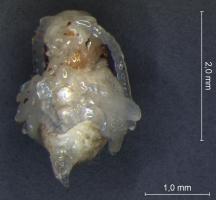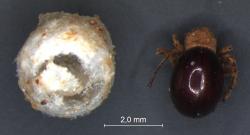Adult
Size
2.5 to 3.5 mm long
Aspect
Look like small spiders, but have only 3 pairs of legs (spiders have 4).
Sturdy, rounded, pearl-shaped body. Upper part of abdomen completely smooth. Fairly long, 11-articled antennae.
Colour
Shiny, fully orange-brown elytra. Head, thorax and legs entirely covered in a dense, scaly, golden or greyish pubescence.


 Ptine luisant
Ptine luisant  Hood Spider beetle shiny Spider beetle shining Ptinus
Hood Spider beetle shiny Spider beetle shining Ptinus  Escarabo araña
Escarabo araña  Kugelkäfer
Kugelkäfer 






